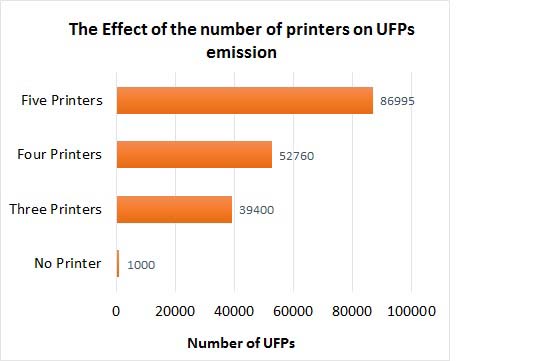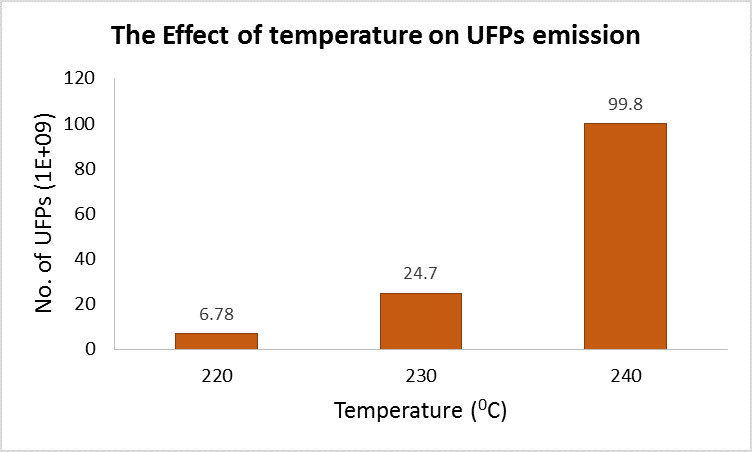Short Communications
3D Printing in Makerspaces: Health and Safety Concerns
Neelam Bharti
Chemical Sciences and Engineering Librarian
George A. Smathers Libraries
University of Florida
Gainesville, Florida
neelambh@ufl.edu
Abstract
3D (three-dimensional) printing is included in makerspaces around the world and has become increasingly affordable and useful. Most makerspaces use Fused Deposition Modeling (FDM)-based 3D printers, using polylactic acid (PLA) and acrylonitrile butadiene styrene (ABS) as printing materials. However, heating PLA and ABS to high temperatures emits ultrafine particles and volatile organic compounds, which are potentially harmful and raise health and safety concerns. This paper discusses the health and safety hazards posed by 3D printing and presents recommendations to minimize the effects of these hazards.
Introduction
As technological horizons have expanded, libraries have embraced changing responsibilities. Shifting information paradigms have inspired libraries to be more engaged and creative. Makerspaces are a great way to engage library users to help the community learn about emerging technologies. Since the inception of the first official makerspace in a New York public library, makerspaces have become popular at media centers, public libraries, and academic libraries (A Librarian's Guide to Makerspaces). Makerspaces are known by a variety of names including fab labs and hack labs and contain a variety of creative resources and technologies. 3D printers are often an important part of makerspaces because they support increased user interaction with technology, community collaboration, and individual entrepreneurship. 3D printing in libraries and makerspaces enables patrons to learn new technology and reinforces learning with hands-on projects. This experience could inspire future engineers, designers, or entrepreneurs while giving them a head start in highly specialized fields.
History of 3D Printing
3D printing has been around since the early 1980s when Hedeo Kodama studied and reported the manufacturing of a printed solid model with additive manufacturing (Kodama 1981). Charles Hull in the 1980s used rapid prototyping technology for creating prototypes at a faster rate for industries (Chuck Hull 2013). Modern 3D technique came into existence in 1986 when the .stl (STereoLithography or Standard Tessellation Language) file format of a model was created using CAD software. The first commercial 3D printer, SLA 250, became available to the public in 1988. In 1990, Scott Crump invented Fused Deposition Modelling (FDM) technology and founded Stratasys (3D Systems 2013). The name "3D printer" was coined by MIT professor Michael Cima in 1993 and was used to describe a printer which could use plastic, metal, or ceramics to print a 3D object (Bharti & Singh 2017). In recent years, 3D printers have become tremendously popular and affordable. Various 3D printing instruments are available using several types of technology and with different material options (Types of 3D Printers). Low-cost desktop versions have made 3D printing technology widely available at home and in the office.
3D Printing Technology, Material, and Applications
The 3D printing process involves using a virtual model of an object created in computer-aided design (CAD) software as a digital file. The printer software slices the file into hundreds of layers. The printer follows the sliced model and prints the object by adding successive layers of printing material on top of others until the model is completed. Printing materials used for 3D printing are influenced by printer design and machine capability. Material used for printing includes resin, powder, and live cells. 3D printing is used across disciplines in education and research (Bharti & Singh 2017).
Health and Safety Concerns
Most makerspaces use fused deposition modeling (FDM)-3D printers and thermoplastic filaments as printing material. The FDM technique employs melted thermoplastic extruded through a nozzle to build the model. Thermoplastic melting at a high temperature causes the emission of organic fumes containing several harmful byproducts, including phenol and styrene. If the binding agent is polycarbonate based, phenol would be a thermal degradation byproduct, which is corrosive and carcinogenic in nature (Davis & Golden 1967). When PLA and ABS are heated above 2200C to extrude through the nozzle, a large amount of ultrafine particles (UFPs) and volatile organic compounds (VOCs) are generated (Bharti & Singh 2017; Azimi et al. 2016). The number of UFPs is directly related to the number of printers in use. Bharti et al. studied the trend and impact of the number of printers on UFP emission in libraries. The average number of UFPs rose from 1,000 (no printer) to 86,995 when five printers were in use (Figure 1) (Bharti & Singh 2017).

Figure 1: The effect of the number of printers in operation on UFPs emission
Temperature plays an important part in UFP emission. Stabile et al. compared the particle emission using PLA heated at different temperatures (Stabile et al. 2016). A 200C increase in printing temperature, from 2200C to 2400C, increased the UFP emission 16-fold (Figure 2). Other studies also support the observed trend (Stephens et al. 2013). There is a good chance that ABS may be more harmful than PLA, due to higher emissions and likely higher toxicity. It is too early to conclude, but emission from 3D printers could potentially be compared to second-hand smoking (Horn 2013).

Figure 2: The effect of temperature on UFPs emission (Stephen et al 2013)
Since most makerspaces use ABS and PLA as printing material, UFPs emitted from 3D printers are a big health concern. When inhaled, these UFPs can end up in body organs and may cause inflammation in the respiratory system and lungs and may possibly reach the bloodstream (Delfino et al. 2005; Anderson et al. 2010; Shead 2013). Elevated UFP concentration is linked to adverse health effects including cardio-respiratory mortality, hospital admissions, stroke, and asthma symptoms. In addition to UFP emission, ABS produces a distinctive smell when heated, causing headaches and respiratory and eye irritation in sensitive people. Some studies show that ABS fumes are toxic to rats and mice (Oberdörster et al. 1995).
Initial studies stated that PLA might be safer than ABS, but a recent study by Steinle showed that PLA emits a higher number of ultrafine aerosol (UFA) particles than ABS (Steinle 2016). UFA emission doubled from PLA and quadrupled from ABS from the same printer once it was used for a few months. Although there is no confirmed evidence, elevated UFP emission could be due to the age of the printer, but more studies are needed to confirm this relationship.
There is a dire need for targeted research on the environmental impact of 3D printing technology in libraries and makerspaces. Many research reports are available on UFP emission from desktop 3D printers, but there are not many studies undertaken in libraries. The availability of such research could help address the potential harmful impact of 3D printing on the user's health and library environment. There are no evidence-based guidelines for makerspace design and implementation. Designing a working makerspace depends on the coordinator's knowledge, which is generally based on scattered information. There should be standard guidelines for makerspaces in libraries and media centers. Implementation of 3D printing services is exciting and scary at the same time. Libraries need to understand that 3D printing will need policies beyond regular material checkout and circulation procedures to deal with real issues of health and safety. Most manufacturers say that 3D printing material is safe and quote the Safety Data Sheet for the safety analysis. The Safety Data Sheet contains material data analysis at the ambient temperature; when PLA or ABS are subjected to printing temperature (220-2400C), the safety analysis changes.
Risk Assessment and Recommendations
3D printing services in libraries are a health and safety concern because of the various hazards associated with 3D printers and the number of people working in the space. In makerspaces, establishing proper policies should be the first step to ensure the safe use of 3D printing in libraries. To control any hazards, good user training and following proper operating procedures is very important to develop a culture of safety. All users should be well aware of the hazards associated with the 3D printers and printing materials, and procedures to be used. Due to the emission of UFPs and VOCs, the 3D printers should be used in a well-ventilated area. Most desktop 3D printers do not have exhaust ventilation accessories though there are commercial enclosures with filtration systems that can be used. PLA seems to be the material of choice for now but fumes from the dye used in color filaments might have their own hazard element.
Besides the emission hazards, other potential risks such as burn hazards (the use of ABS requires a hot plate) and fire risks (like any other electrical gadget with a heating component) are also involved. There is evidence that 3D printers can catch fire (Watkin 2015), therefore flammable materials, as well as papers, should be stored away from 3D printers.
Conclusion
FDM-based 3D printers in makerspaces are becoming a health and safety concern due to the emission of UFPs and VOCs. Before including 3D printers in makerspaces, a proper risk assessment should be performed, the manufacturer guidelines should be followed, and only the recommended materials should be used for printing. Standard operating procedures and Safety Data Sheets should be available for all printing materials and any other chemical products used in the printing process. Most importantly, printers should be operated in a well-ventilated area.
Acknowledgement
Thanks to Dr. Shailendra Singh for constructive suggestions and Mr. Jose Baca for editorial assistance.
References
Anderson, Z.J., Olsen, T.S., Andersen, K.K., Loft, S., Ketzel, M. & Raaschou-Nielsen, O. 2010. Association between short-term exposure to ultrafine particles and hospital admissions for stroke in Copenhagen, Denmark. European Heart Journal. 31(16): 2034-2040, DOI: 10.1093/eurheartj/ehq188
Azimi, P., Zhao, D., Pouzet, C., Crain, N. E. & Stephens, B. 2016. Emissions of ultrafine particles and volatile organic compounds from commercially available desktop three-dimensional printers with multiple filaments. Environmental Science & Technology. 50(3): 1260-1268. DOI: 10.1021/acs.est.5b04983
Bharti, N. & Singh, S. 2017. Three-Dimensional (3D) printers in libraries: Perspective and preliminary safety analysis. Journal of Chemical Education. 94(7): 879-885. DOI: 10.1021/acs.jchemed.6b00745
Chuck Hull: Pioneer in Stereolithography. 2013. SPIE Professional. DOI: 10.1117/2.4201301.03
Davis, A. & Golden, J. H. 1967. Thermally-induced cross-linking of poly[2.2-propane-bis-(4-phenyl carbonate)]. Macromolecular Chemistry & Physics. 110(1): 180-184. DOI: 10.1002/macp.1967.021100118
3D Systems. 2013. 30 Years of Innovation. [cited 2017 August 24]. Available from https://www.3dsystems.com/our-story
Delfino, R. J., Sioutas, C. & Malik, S. 2005. Potential role of ultrafine particles in associations between airborne particle mass and cardiovascular health. Environmental Health Perspective. 113(8): 934-946, DOI: 10.1289/ehp.7938
Horn, L. 2013. 3D Printing Indoors Is as Bad for You as Smoking a Cigarette Inside. [cited 2017 August 24]. Available from http://gizmodo.com/3d-printing-indoors-is-as-bad-for-you-as-smoking-a-ciga-894193776
Kodama, H. 1981. Automatic method for fabricating a three-dimensional plastic model with photo-hardening polymer. Review of Scientific Instruments. 1770-1773. DOI: 10.1063/1.1136492
A Librarian's Guide to Makerspaces: 16 Resources. [cited 2017 August 24]. Available from http://oedb.org/ilibrarian/a-librarians-guide-to-makerspaces/
Oberdörster, G., Celein, R.M., Ferin, J. & Weiss, B. 1995. Association of particulate air pollution and acute mortality: involvement of ultrafine particles? Inhalation Toxicology. 7: 111-124. DOI: 10.3109/08958379509014275
Shead, S. 2013. Scientists warn of 3D printing health effects as tech hits high street. Techworld. [cited 2017 August 24]. Available from http://www.techworld.com/news/personal-tech/scientists-warn-of-3d-printing-health-effects-as-tech-hits-high-street-3460992/
Stabile, L., Scungio M., Buonanno, G., Arpino, F. & Ficco, G. 2017, Airborne particle emission of a commercial 3D printer: the effect of filament material and printing temperature. Indoor Air. 27, 398-408. DOI: 10.1111/ina.12310
Steinle, P. 2016. Characterization of emissions from a desktop 3D printer and indoor air measurements in office settings. Journal of Occupational and Environmental Hygiene. 13(2): 121-132. DOI: 10.1080/15459624.2015.1091957
Stephens, B., Azimi, P., El Orch, Z. & Ramos, T. 2013. Ultrafine particle emissions from desktop 3D printers. Atmospheric Environment. 79, 334- 339, DOI: 10.1016/j.atmosenv.2013.06.050
Types of 3D Printers or 3D Printing Technologies Overview. 3D Printing from Scratch. [cited 2017 August 24]. Available from http://3dprintingfromscratch.com/common/types-of-3d-printers-or-3d-printing-technologies-overview/
Watkin, H. 2015. Fire safety: Unattended 3D printer nearly burns house down. All3DP. [cited 2017 August 24]. Available from https://all3dp.com/fire-safety-unattended-3d-printer-nearly-burns-house-down/

This work is licensed under a Creative Commons Attribution 4.0 International License. 